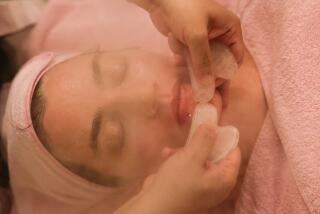Collagen Is a Smoothie, but Price Is One of Its Wrinkles
- Share via
Whoever said it pays to be beautiful neglected to mention how much it costs. But price has not been a factor for about 250,000 men and women who have added collagen injections to their beauty budgets in the last five years.
Often for a four-digit price tag, these skin-plumping-treatments-in-a-syringe can reduce wrinkles and fill in scars. The cost, and the fact that doctors alone can administer collagen, make it the sort of youth extender that used to be exclusive to the very rich.
But not anymore. To show how the mighty have fallen, neither celebrities nor socialites nor captains of industry hold sway. Of the thousands who have tried the treatment since it was approved by the Food and Drug Administration in 1981, a hefty portion are baby boomers working hard for the money, says Maureen Brunner of the Collagen Corp. in Palo Alto, Calif., the exclusive supplier of the product.
“When I started giving collagen injections five years ago, most of my patients were actors, actresses and models,” recalls Dr. Edward Tobinick, a Beverly Hills dermatologist who was among the first to offer the treatments. “Now it’s become a household item. A beauty aid for housewives.”
Although it’s possible to get a single injection for about $200, Brunner estimates that the price of the initial investment generally ranges from $500 to $1,000, depending on the depth and breadth of the wrinkles.
The effect is not permanent, however, because the bovine-based material is natural and subject to decomposition. To remain wrinkle free requires regular booster injections that add about another $250 to $500 to a user’s annual bill.
Collagen: The word comes from the Greek for “glue” and defines a natural substance found in the dermis of mammals.
Plastic surgeons and dermatologists first used it to plump up depressions made by surgical scars and acne pits. But Brunner says her company’s statistics show that 80% of current users have no other motive than to round out their wrinkles.
The success rate of the shots doesn’t enhance the reputation of the collagen-containing moisture creams that many leading cosmetic companies offer.
“Medical science tells us, anything put on the surface of the skin is not taken into the skin,” Dr. Frank M. Kamer, a Beverly Hills plastic surgeon and early tester of collagen injections, reminds patients.
Traditional Tools
As for face lifts--more traditional tools in the war on facial flaws--they seem to be in no danger of sagging sales despite the growing popularity of collagen-injection treatments.
“Collagen isn’t a replacement for a lift,” says Dr. Richard Strick, associate professor of medicine and co-director of Dermatological Surgery Training at UCLA.
Often, he points out, the two treatments are used together. A lift, which has never claimed to erase facial lines but will reduce sagging, is followed by collagen injections that will soften those lines cosmetic surgery can not remove.
Interestingly, the more popular collagen treatments become, the less inclined plastic surgeons are to administer them. Many now refer patients to dermatologists.
“I don’t have time to give injections,” Kamer says.
Strick explains that many plastic surgeons do as Kamer does, for financial reasons.
“They perform other techniques that are very lucrative,” he says. “It’s not cost effective for them to take time giving collagen treatments.”
Brunner at the Collagen Corp. says a doctor’s accumulated experience with the material is not an important requisite for a successfully administered collagen injections. But dermatologists absolutely disagree.
“The art of injecting collagen is completely technique dependent,” Tobinick says. “Knowing where to inject it, how to feather the edges and blend it, knowing at what rate to inject and how to mold the material under the skin within 60 seconds of an injection are very significant things.”
Even in experienced hands, there are risks to be considered. Of these, the worst is the danger of an allergic reaction--often in the form of a bumpy, red rash--that takes up to a year to clear.
UCLA’s Strick points out: To reduce that possibility, doctors require at least one, sometimes two, skin tests before giving a full treatment. Statistics show that only about 3% of potential users prove to be allergic, he explains. But, he adds, in a small percentage of cases, reactions are delayed.
If collagen is injected into very thin skin, the material can form beads or bumps that can remain visible for several months, Strick says. And to make a temporary treatment even more transient, if it is injected too deeply into the skin, collagen is absorbed immediately and has no visible effect, Strick says.
Not a Panacea
Dr. Eugene Worton, Cedar-Sinai’s chief of plastic surgery, is emphatic when he says: “Collagen is not a panacea. It’s not medicine. It’s like having your hair done.” He explains that collagen is most effective on deep furrows, such as those between the eyebrows or beside the nose, but it does not take the place of plastic surgery.
“All the collagen in the world isn’t effective if the skin is too loose; it’s not going to work for everyone in every situation. It’s useful when it’s used in the right place to correct the right deformity,” Worton says.
When asked if there is a problem of collagen migrating, he answers: “It doesn’t migrate, it absorbs, it goes away.”
About a year ago--in an effort to extend the effects of a treatment--the Collagen Corp. introduced a second formula, Zyplast. But it is only intended for deeper facial lines.
Lasts About Six Months
“It’s a more robust, intense material that lasts nine to 12 months,” says the corporation’s Brunner. (Doctors have found that the original formula, called Zyderm, lasts about six months.)
Despite the drawbacks and the expense, many Los Angeles users keep going back for more. (This city, along with New York, boasts the highest number of users, Brunner says; other high-rated cities are in Florida and Texas.)
One single businesswoman in her late 30s will only talk about her collagen habit if her name is withheld. (“I don’t want to be associated with vanity,” she explains.)
She uses collagen primarily for social reasons.
“I’m competing with much younger women for dates,” she says. The men in their 40s who she finds attractive, “are looking for 20-year-old girls.”
She says her collagen injections, her weekly manicures and her regular facials, are “maintenance, like having my teeth cleaned.”
Men Are Clients Too
Although most users are women, Dr. Peter Goldman, a Beverly Hills dermatologist, reports that he gives thousands of collagen treatments a year and 30% of his clients are men.
One regular patient, Michael Epstein, 31, owns a singles club, “The Elite Connection,” in Encino. He says he recommends collagen openly and that he knows several men his own age who are also users. But he finds that the older men he knows, while willing to try everything from facials and manicures and hair coloring to collagen and even cosmetic face lifts, are reluctant to own up to any such beauty treatments.
“I ran into this 70-year-old Hollywood producer I’ve known for a long time who gets manicures where I do,” Epstein recalls. “He looked terrific but wouldn’t admit he’d had anything done to his face. All he’d say was he felt rested.”
That, by the way, is a collagen user’s favorite phrase.
More to Read
Inside the business of entertainment
The Wide Shot brings you news, analysis and insights on everything from streaming wars to production — and what it all means for the future.
You may occasionally receive promotional content from the Los Angeles Times.










